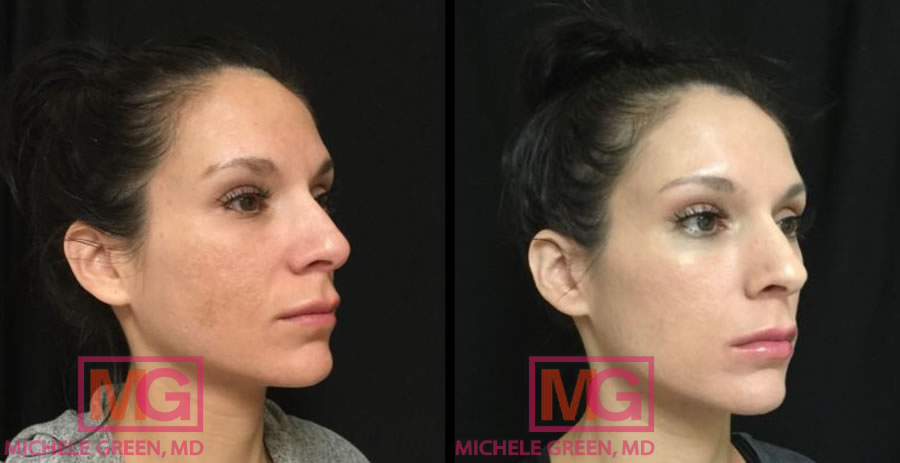Chemical Peel
Chemical peels have been one of the most popular cosmetic procedures in the United States for over two decades due to their ability to treat a wide range of skin concerns in patients of different skin types and skin tones. Chemical peels help treat fine lines and wrinkles, sun damage, rosacea, acne breakouts, acne scars, hyperpigmentation, sun spots, dullness, and discoloration. A chemical peel is usually done at an office or outpatient surgical facility, depending on the strength and type of peel. Chemical peels have remained a staple cosmetic procedure in Dr. Michele Green’s private dermatology office, located in the Upper East Side neighborhood of Manhattan, and have yielded incredible results for her many patients.
Chemical peels work to exfoliate the skin, removing dead, pigmented skin cells to bring healthy, bright cells to the surface. There are numerous types of chemical peels, including those that use alpha-hydroxy acids, glycolic acids, and trichloroacetic acids, as well as Cosmelan peels, Vi Peels, mesopeels, and dermamelan peels. Each peel is suited to treat a certain skin type, tone, and concern. With so many options available to choose from, it can be challenging to know for sure which chemical peel would be the best fit for you to reach your desired appearance. Selecting the correct strength and type of chemical peel, based on your skin type and underlying skincare concerns, is critical to having the best cosmetic results. Dr. Green is an expert in chemical peels and can determine which peel is ideal based on your skin type, the skin conditions you’d like to address, and your overall skincare goals to help you achieve clear, radiant skin.
Dr. Green is an internationally renowned board-certified cosmetic dermatologist with over 25 years of experience providing some of the most discerning men and women worldwide with the best non-invasive cosmetic treatment options, including chemical peels. For her dedication to her patients and expertise, she is consistently voted as one of the best dermatologists in NYC by Castle Connolly, the New York Times, Super Doctors, and New York Magazine. When you consult with Dr. Green for your facial rejuvenation treatment, she will work with you to create a customized approach that includes a unique combination of in-office cosmetic procedures and specially formulated skincare products best suited to your specific needs and goals.
What is a chemical peel?
A chemical peel is a non-invasive skin resurfacing cosmetic procedure that entails applying a chemical solution to the skin’s surface to remove the outer layers of skin. The chemo exfoliation process accelerates the rate of skin cell turnover, revealing new, healthy skin cells that appear more even in tone and texture. As a result, a chemical peel corrects skin discoloration, unclogs pores, and gives the skin a vibrant glow. A chemical peel treatment can improve the appearance of many skin conditions, including acne breakouts, acne scars, hyperpigmentation, fine lines, irregularities in skin texture, dullness, and sun-damaged skin, among others. There are different strengths and types of chemical peels that will determine how deep the peel will penetrate the skin and its subsequent effects. According to the most recent plastic surgery statistics report from the American Society of Plastic Surgeons, chemical peels remain among the top five most popular minimally invasive cosmetic procedures in the United States. Since chemical peels are non-invasive and don’t necessarily require a lengthy downtime, patients often combine their peel treatments with other non-invasive cosmetic procedures, including cosmetic injectables and laser resurfacing treatments, to achieve pan-facial rejuvenation results.
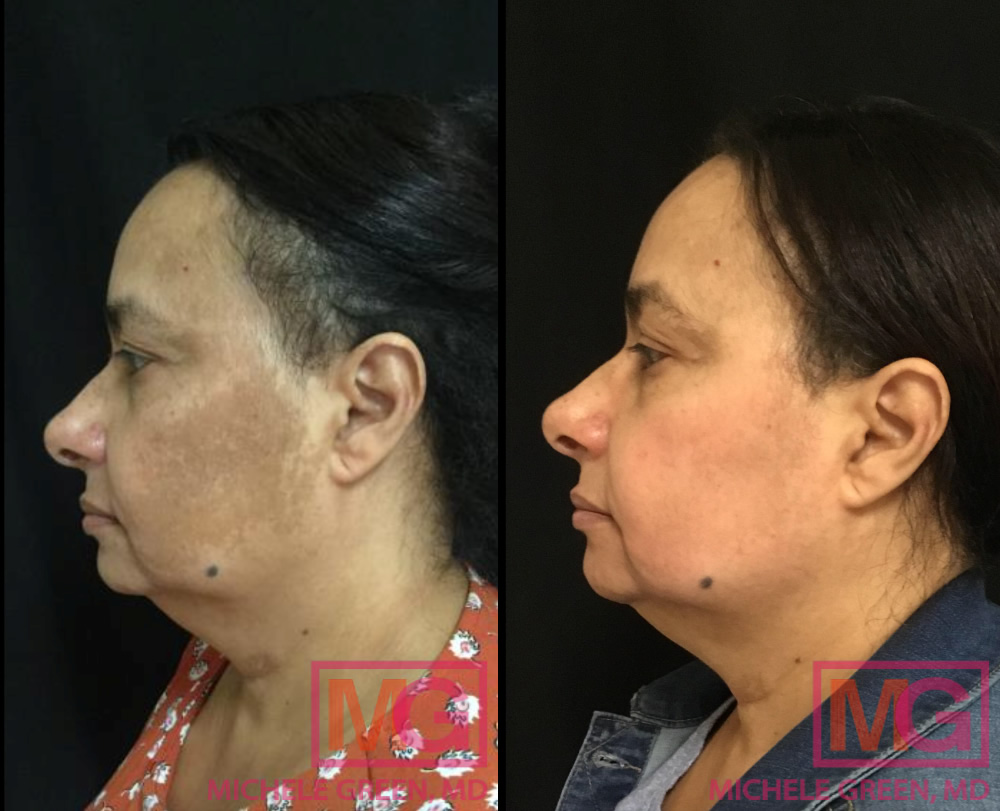
55-64 year old woman treated with chemical peels
What does a chemical peel do?
The exact action of the chemical peel will depend on the ingredients it is formulated with. However, chemical peels mainly work to increase the rate of cell turnover by exfoliating or sloughing off dead, pigmented skin cells. Some peels focus on the epidermis, or the top layer of skin, while others focus on the dermis or the deeper layer of skin. Once the dead cells are removed, new, healthy skin cells are revealed to create a glowing complexion. Additionally, many chemical peels promote collagen production, a skin protein that is essential for maintaining firm, smooth skin. As collagen levels increase, patients can expect to achieve clear, radiant skin.
What do acid chemical peels do?
The most common chemical peels are acid peels, which break the weak chemical bonds on the outermost layer of the skin. Once these chemical bonds are broken, the cells slough off and make room for a new layer of skin that is more even in skin tone and texture. The exfoliative effects of chemical peels also stimulate new epidermal growth and collagen with more evenly distributed melanin. With a superficial acid peel, epidermal regeneration is limited to the epidermis (topmost layer of skin) and occurs within 3 to 5 days. Medium-depth acid peels go to the epidermis-dermis interface, and epidermal regeneration can take about one week. Deeper acid peels, which are more potent and remove more layers of skin, may require two to three weeks of downtime.
What does a chemical peel treat?
Chemical peels treat a variety of skin concerns, including:
- Sun damage
- Actinic keratoses or pre-cancers due to sun exposure
- Hyperpigmentation
- Melasma
- Age spots
- Sunspots
- Freckles
- Post-inflammatory hyperpigmentation (PIH) from acne marks or improper laser treatments from resurfacing lasers
- Skin texture issues
- Acne scars
- Acne
- Rosacea
- Fine lines and wrinkles
A chemical peel should be selected based on your specific complexion concerns and the severity of changes in your skin. When skin changes are limited to the superficial layers of the skin, including increased skin pigmentation and skin texture, they can be treated with a superficial peel. When the textural changes include deeper wrinkles around the eyes and mouth, a deeper type of chemical peel will be required. The most severe changes in the skin include generalized deep wrinkling with a leathery appearance, which may require a deeper form of chemical peel. Again, these skincare concerns must be treated within the context of a patient’s skin type since patients with darker skin tones can tolerate light or medium types of chemical peels.
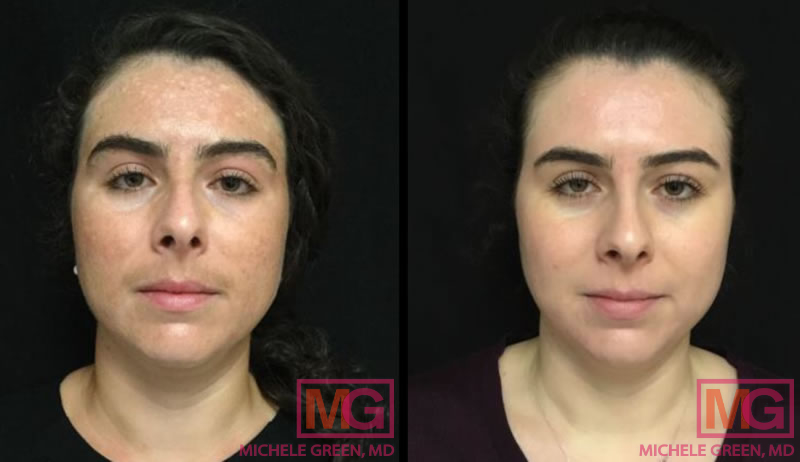
How are chemical peels classified?
The American Society of Dermatology has categorized chemical peels into three levels: light, medium, and deep. These levels depend on several factors, from the type and concentration of the peeling solution to the depth at which the peel penetrates. The three levels of chemical peels are optimal for different skin conditions and tones and have different recovery times.
Light Chemical Peels
Light chemical peels affect the superficial layers of skin and are often referred to as “lunch” time peels. This type of chemical peel is perfect for someone with relatively good skin seeking revitalization. Light chemical peels can treat superficial fine lines, acne breakouts, and dry skin, in addition to correcting uneven skin tone and texture. Light chemical peels can be done as often as every two weeks for several months. Light peels generally have very little downtime and peel for just a few days. Patients can return to work immediately after a light peel since there is only some mild dryness, redness, and irritation as your skin exfoliates the dead skin.
Medium Chemical Peels
Medium peels treat deep lines and wrinkles, melasma, acne scars, PIH, and skin discoloration/pigmentation. The chemicals in these peels are more concentrated and penetrate deeper into the skin than light chemical peels. This type of chemical peel will exfoliate your skin, and it is expected to experience redness and tightness in the treatment area immediately after the procedure. Moisturizers, lotions, and sunscreen should be used throughout this process, and strict sun avoidance is essential to prevent a recurrence of the underlying skin condition. Medium peels generally peel for 7 to 10 days.
Deep Chemical Peels
Dermatologists and plastic surgeons use deep chemical peels to treat deeper lines and wrinkles, severe acne scarring, pre-cancerous cells, and extensive sun damage. These peels penetrate the dermal layers of the skin and often include phenol acid as one of their peeling agents. There are special considerations for deep peels, such as skin tone, use of anesthetic, and who can perform this procedure. Patients with darker skin tones should stick with light to medium peels, as deep peels can cause adverse effects like hyperpigmentation and skin discoloration. Deep peels often require the use of a numbing agent or sedation and should only be performed by a board-certified dermatologist like Dr. Green. Potential side effects of improperly performed deep chemical peels include blisters and burns. The recovery period is usually two to three weeks, during which skin crusting may occur, and you will need to practice strict sun avoidance and apply SPF 50 consistently. Proper sun protection, including appropriate use of sunscreen, is essential following a chemical peel. The American Academy of Dermatology reports that while 80% of Americans understand the importance of reapplying sunscreen, only around 30% actually do. Sun exposure following a chemical peel treatment can result in skin irritation and even permanent damage. When you work with Dr. Green for your chemical peel procedure, she will provide you with all of the pertinent aftercare information necessary for achieving and maintaining optimal results.
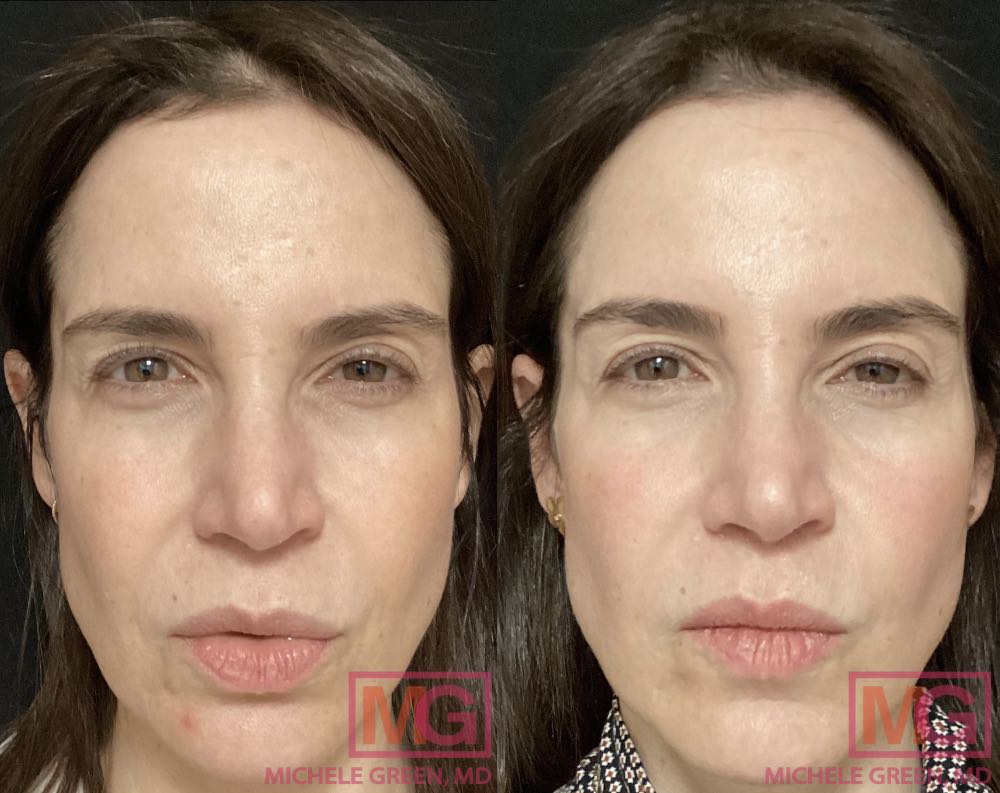
What are the types of chemical peels?
There are many different types of chemical peels that Dr. Green selects for her patients based on their skincare concerns, skin type, skin tone, and the areas of the body being treated with the chemical peel. The different types of chemical peels used include acids such as beta hydroxy acids (BHAs), alpha-hydroxy acids (AHAs), lactic acid, Jessner solution, and trichloroacetic acids (TCAs), among others that are applied topically to the skin. These acids, through a chemical reaction with the skin, gently penetrate the layers of the skin, breaking down dead skin cells. The chemical reaction with the skin causes the dead skin cells to peel off gently. The shedding of dead skin cells can be dramatic or superficial, depending on the type of acid and the strength used. Chemical peels can have light, medium, or deep peels and may require different chemical formulations based on your desired results.
Different parts of the body also require treatment with different types of acids. For example, the delicate axillae (underarms) or bikini and inner thigh area need a gentler chemical peel. For these delicate areas, mesopeels are the most effective, as you do not risk hyperpigmentation or additional irritation. Cosmelan peels are the most effective treatment for melasma on the face and chest and produce excellent results for melasma and pigmentation due to hormonal imbalance and post-inflammatory hyperpigmentation (PIH). Dermamelan Intimate peels are specifically formulated for the vaginal area to create safe and effective skin lightening in this delicate area. Choosing the best type of chemical peel for the area of the body, whether it be your face, back, décolletage, neck, or intimate area, is the key to having the best cosmetic results.
What is a TCA chemical peel?
The TCA peel is one of the most popular cosmetic procedures offered at Dr. Green’s private dermatology office in Manhattan’s Upper East Side neighborhood. TCA stands for trichloroacetic acid, the most common chemical solution used for medium-depth peels in cosmetic dermatology. A medium-depth peel exfoliates just the top layer of skin and the immediate underlying layers. There are varying strengths of TCA used, ranging from 15-50%. High concentrations of TCA may be used for a deeper peel, affecting more of the underlying layers of skin. The amount of downtime required following a TCA chemical peel can vary depending on the strength used, ranging from one day of downtime with a light peel to 14 days for a deeper peel. TCA peels are ideal for improving skin tone and texture and can target concerns including fine lines, acne scars, active acne, enlarged pores, hyperpigmentation, and other signs of aging. TCA peels are not recommended for patients with darker skin tones, who are at higher risk of hypopigmentation and post-peel discoloration and hyperpigmentation.
Mesopeel chemical peels for the face and body
Mesopeel is a specially formulated chemical peel that addresses all types of hyperpigmentation and helps to control melanocyte activity. In addition to the face, mesopeels are used to treat many delicate areas of the body, such as the axillae (armpits), groin, inner thighs, and under-eye areas that are too sensitive to treat with traditional chemical peels. Its formulation includes azelaic acid, resorcinol phytic acid, and tranexamic acid, all scientifically proven skin-lightening ingredients. These ingredients, through the process of chemo exfoliation, create an inflammatory reaction in the reticular dermis and induce new collagen and elastin production. When coming for a mesopeel appointment, Dr. Green will apply the mesopeel for a specified time, depending on which area of the face and body you want to be treated.
There is no downtime with the Mesopeel, and patients can resume their daily activities afterward, so long as they use sunscreen and stay out of the sun. As with most chemical peels, multiple mesopeel treatment sessions spaced three to four weeks apart are typically required to have the best cosmetic results. Mesopeels are a great chemical peel option for patients with darker skin tones who cannot tolerate TCA peels, which can cause hypopigmentation, hyperpigmentation, and discoloration.
Mesopeel Periocular chemical peels for the eye area
Mesopeel periocular is a recent combination peel launched by the company Mesoestetic and is now available to patients in our NYC office. It is a unique chemical peel designed for the sensitive skin on the eyelids and is formulated with azelaic acid, salicylic acid, lactic acid, resorcinol, citric acid, and phytic acid. These ingredients specifically aid in reducing the wrinkles in the eyelids (upper and lower), crow’s feet, hyperpigmentation, skin laxity, under-eye circles, and loss of brightness. If you have tired-looking eyes and want a non-surgical cosmetic procedure for improving their appearance, Mesopeel Periocular is an amazing anti-aging chemical peel to accomplish your eye rejuvenation.
Before & After – 3 weeks
Cosmelan chemical peels to treat melasma
The Cosmelan peel is a professional-grade mask that actively works to depigment your skin. Its formulation contains key tyrosinase inhibitors, which block the production of melanin in the skin, and other lightening agents to restore beautiful, clear skin. It can treat various conditions, from melasma, age spots, blemishes, and skin discoloration, among others. The Cosmelan peel entails applying a mask to the pigmented area that is washed off after a specified time decided by Dr. Green. Afterward, a strict protocol of specially formulated creams must be followed to reduce hyperpigmentation or melasma further. These creams include hydroquinone, vitamin K, sunscreen, and a uniquely formulated Cosmelan 2 product. Dr. Green has her patients follow up in four weeks to track the progress of treatment, at which point she may apply the mask for a second time. Patients have seen great results from the Cosmelan peel, and for many, Cosmelan is the only thing that has worked for melasma. If you have tried other treatments for melasma without improvement, Cosmelan may be the best treatment for you.
Dermamelan Intimate peel for vaginal pigmentation and discoloration
The breakdown of collagen and elastin that occurs as we age is often accompanied by increased hyperpigmentation and darkening of the skin around the external genital and inner thigh area. This is a result of increased estrogen activity, which can increase levels of tyrosinase, an important enzyme for melanin (skin pigment) production. External factors like dry skin, certain medications, friction, and hair removal can then worsen the hyperpigmentation and discoloration. Dermamelan intimate can reduce pigmentation in the external genital area, groin, and inner thighs through its depigmentation action and anti-aging effects. The dermamelan treatment consists of two phases: one in-office peel that consists of several steps and at-home maintenance with the dermamelan intimate home depigmenting gel cream. These two phases work to remove existing hyperpigmentation and discoloration, increase the production of new collagen and elastin, and prevent future hyperpigmentation from occurring.
What is a Vi Chemical Peel?
A Vi Peel is a medium-depth chemical peel formulated with salicylic acid, Vitamin C, TCA, and retinoic acid. It helps treat discoloration from sun damage, melasma, and acne scars. It improves the appearance of pores, fine lines, acne, and texture irregularities. The Vi peel works by removing the dead skin, and new healthy skin tissue is stimulated, which improves fine lines, wrinkles, and pigmentation. The full effects of the Vi peel generally take one week, as the skin exfoliates and new glowing skin is produced. Patients can expect a week of recovery time that includes mild peeling, redness, and irritation.
Can you do a chemical peel on your body?
Yes, chemical peels can be used on the body and face to correct uneven skin tone, texture, hyperpigmentation, sun damage, fine lines, wrinkles, acne, and acne scars. Chemical peels can be performed on:
- Face
- Neck
- Chest/decolletage
- Back
- Buttocks
- Legs
- Arms
- Inner thighs
- Axillae
- Vaginal area
Who should get a chemical peel?
Chemical peels are offered in various types and strengths, meaning that patients of essentially any skin type, skin tone, and age can benefit from having one. For patients with darker skin tones, they are often one of the only treatment options to eliminate sun spots and hyperpigmentation without increasing the risk of adverse side effects. Patients who are interested in achieving a complexion that is more even in tone and texture without the need for an invasive cosmetic procedure or lengthy downtime may be perfect for a chemical peel treatment.
Patients should not get a chemical peel if they have taken isotretinoin (Accutane) within the last six months. Patients with a personal or family history of keloid scars should take precautions with chemical peel treatments and be sure to let Dr. Green know of this before undergoing treatment. Pregnant and breastfeeding patients should not have chemical peels, as their safety has not yet been established. A chemical peel should not be performed if you have an active cold sore, eczema flare, or psoriatic flare. When you consult Dr. Green at her private dermatology office in Manhattan’s Upper East Side neighborhood, she will collect a thorough medical history, review any previous cosmetic procedures you’ve had, and physically assess your skin condition to determine whether you’re a good candidate for a chemical peel treatment. If you are a good candidate, Dr. Green will recommend the strength and type of chemical peel best suited to your needs and goals.
What is the process of having a chemical peel?
The first step is to consult an experienced board-certified dermatologist, such as Dr. Michele Green, in NYC. Working with a board-certified dermatologist or dermatologic surgeon helps guarantee that your chemical peel is safe and effective and provides optimal rejuvenation results. During your initial consultation, Dr. Green will physically evaluate your skin condition, review your cosmetic concerns and aesthetic goals, and determine whether you are a good candidate for a chemical peel treatment. Once it has been determined that you are a suitable candidate for treatment with a chemical peel, the procedure may be performed on the same day or scheduled for a later date, depending on time allowance and preferences. Patients prone to cold sores or Herpes simplex I will be pre-treated with Valtrex, an antiviral medication, to minimize the risk of any breakout.
On the day of the chemical peel, Dr. Green will apply the chemical solution to the outer layer of skin in the treatment area. It is normal to experience a mild tingling sensation or feel some heat on the skin when the chemical solution is applied to the skin’s surface. Depending on the type of chemical peel, a neutralizing solution or cool compress may be applied to the skin to complete the procedure. Dr. Green will provide all of the pertinent aftercare information necessary for achieving and maintaining your ideal results. Most patients require a short initial series of chemical peels to achieve optimal results. Dr. Green will develop a timeline with you for your chemical peels and assess the progress of your treatments during each follow-up appointment. Depending on the type of chemical peel performed, some mild redness, peeling, swelling, or crusting may develop the next day and persist for several days before resolving. Dr. Green will provide you with all of the aftercare information required to achieve and maintain the ideal cosmetic results.
How long does a chemical peel take?
The chemical peel itself is extremely quick and can take as little as a few minutes by an experienced board-certified dermatologist. Peeling will generally start 48 to 72 hours after the treatment and can last up to five-plus days, depending on the type and concentration of the peel. A superficial chemical peel can take a few minutes to complete, while a medium chemical peel can take 15 minutes, and a deep peel can take up to 60 minutes.
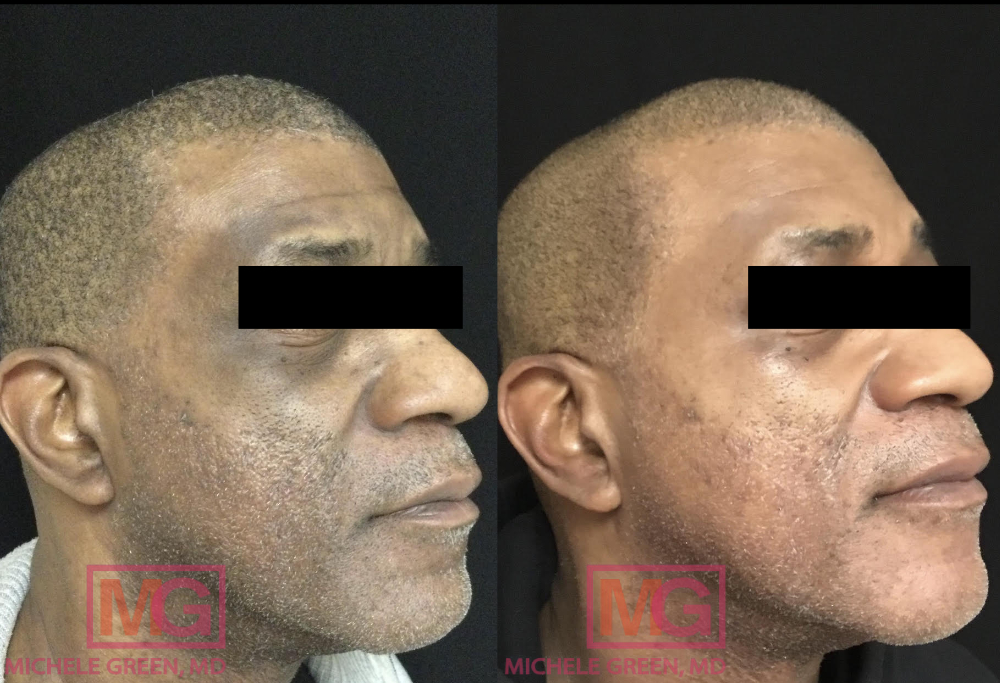
45-54 year old man treated with Cosmelan & Chemical peels – 2 months
What are the side effects of a chemical peel?
A light to medium-depth chemical peel is not uncomfortable. Most patients experience a warm to somewhat hot sensation that lasts for five to ten minutes. A mild stinging sensation may follow this. However, a deep chemical peel is much more invasive, requires general anesthesia, a long recovery time, and may require pain medication both during and after the procedure. The recovery time associated with a chemical peel treatment will depend on the strength and type of chemical peel used. A superficial peel has a recovery period of a few hours to a few days, depending on how sensitive your skin is and your skin type. Recovery from a medium-depth peel generally takes about one to two weeks. A deep chemical peel will take several weeks to months to completely recover. In addition, a light peel may result in mild flaking or peeling for several days, while a deep peel may blister and swell for several weeks. When a chemical peel is performed incorrectly or on the wrong skin type or tone, more severe side effects can occur. Some of these side effects include scarring, hyperpigmentation, hypopigmentation, and infection. Consulting with an expert, board-certified dermatologist like Dr. Green is always best to avoid adverse side effects and achieve radiant skin both safely and effectively.
What should I expect after a chemical peel?
After treatment, the skin is more sensitive while regenerating new skin cells. It is crucial to avoid heavy exercise or heat, including saunas, steam rooms, hot showers, and hot tubs, for 72 hours, as this can lead to discomfort, swelling, and skin irritation. Also, avoid sun exposure, retinol, tretinoin, topical exfoliants, adapalene, tazarotene, benzoyl peroxide, salicylic acid, and glycolic acid for at least one week following treatment. When you have chemical peel treatment with Dr. Green at her private dermatology office in NYC, she will provide you with all of the pertinent aftercare information required for achieving and maintaining optimal results based on your specific chemical peel.
Do chemical peels hurt?
During a chemical peel, you may feel itching, stinging, or a burning sensation, which can last for a few minutes. Dr. Green will apply cold compresses immediately after your chemical peel, neutralizing the acid and relieving any discomfort. Deeper chemical peels may require oral pain medications or IV sedation for pain management, but these are controlled chemical peels that are more uncommon nowadays.
Skincare regimen pre- and post-chemical peels
The skincare regimen before and after a chemical peel is essential in ensuring maximal effects. Strict adherence to it can further reduce hyperpigmentation while preventing it from reoccurring in the future. The recommended skincare regimen for a chemical peel often includes retinol, skin-lightening products, serums, gentle cleansers, moisturizers, and sunblock. Prior to getting a chemical peel, Dr. Green will review your skin care regimen and practices to prevent any unwanted side effects and guarantee optimal results.
For the week before your procedure, you should avoid extensive sun exposure, refrain from facial waxing, and discontinue certain acne products like benzoyl peroxide gel and EpiDuo Forte, as they can dry out your skin and worsen irritation from your chemical peel. Depending on your skin type and the reason for the chemical peel, you may be prescribed a topical retinoid or hydroquinone cream to pre-treat the skin. Retinoids and hydroquinones are particularly beneficial for treating hyperpigmentation or sun damage.
After the chemical peel, it is common to experience flaking, moderate shedding, and general skin tightness for a few days afterward. As new skin forms, you do not want to pick or scrape off the peeling skin, which may lead to scarring. During this time, you must be extremely gentle with your skin, limiting your skincare products to a gentle cleanser and rich, nourishing moisturizers and lotions free from exfoliants such as retinoids or alpha hydroxy acids. In addition, proper sunscreen use is crucial to prevent hyperpigmentation, discoloration, or melasma from occurring. It is extremely important to avoid all sun exposure since this can worsen or cause a recurrence of the skin condition that the chemical peel is being utilized to treat. The best sunscreen for discoloration is a broad-spectrum sunscreen with a minimum SPF of 50. For maximum protection, patients should layer a chemical sunscreen, which turns UV radiation into heat energy, and a physical sunscreen, which creates a barrier against UV rays. Sunscreen should be reapplied every 90 minutes or after going swimming.
In general, five to seven days after your chemical peel, you can resume with your usual skincare products, including any acne treatments, retinol, Vitamin C serums, anti-aging serums, and Retin-A cream. Depending on your skin condition, type, and particular needs, Dr. Green may also prescribe a topical skin-lightening cream, such as one containing hydroquinone, to further aid in depigmenting the skin. As retinols, retinoids, and hydroquinone increase the photosensitivity of the skin, it is essential only to use these products at night and to discontinue or reduce the frequency of usage if any irritation occurs. Again, proper sun protection is essential for the success of your chemical peel.
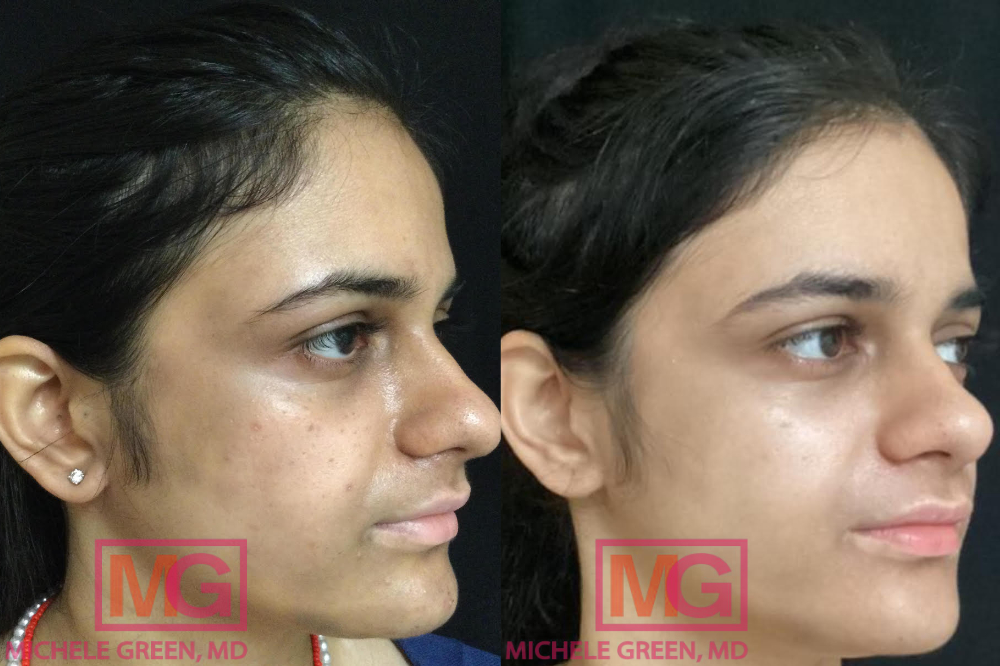
Before and after Cosmelan Treatment
How much does a chemical peel cost?
The cost of a chemical peel greatly varies depending on geographic location, the type of chemical peel, and the experience of the provider. A chemical peel in a metropolitan area may be more costly than one in a suburban area. Light chemical peels typically cost less than medium or deep chemical peels, with prices around $700. A deep chemical peel can be very costly, especially if it requires anesthesia, and prices can range anywhere from $2500 to $6000. Additionally, while a board-certified dermatologist may be more costly than a nurse at a MedSpa, it is crucial to have your chemical peel performed by an expert to minimize the risk of infection, scarring, and hyperpigmentation. Dr. Green has over 25 years of experience in the field of cosmetic dermatology and is an expert at choosing a chemical peel best suited for a specific skin type, tone, and concern.
Are chemical peels safe?
A chemical peel is an entirely safe, non-invasive cosmetic procedure when performed by a board-certified and experienced dermatologist like Dr. Michele Green. However, chemical peels are associated with many potential risks and uncertainties, especially when inexperienced providers perform treatment. A chemical peel treatment with an inexperienced provider may increase your risk for adverse side effects like scarring, skin discoloration, and infection. They also may lack the expertise to determine what the best pre- and post-chemical peel care should be and what chemical peel would be ideal for your skin concerns and skin color. The safest and most effective chemical peel treatment is always done with a board-certified dermatologist, like Dr. Green in NYC.
How often should you get a chemical peel?
The frequency of a chemical peel depends on the type of peel and the condition that you are treating. Some peels, like the Mesopeel, require four to six treatments spaced four weeks apart, while other peels, like the Cosmelan, require one to two applications for optimal results. If you are treating acne, you can have a series of peels every two to four weeks to exfoliate and improve your acne breakouts. If the chemical peels are being performed for discoloration or hyperpigmentation, these chemical peels may be performed every four weeks until all of the discolorations are resolved. Generally, with a moderate amount of hyperpigmentation, five to six chemical peels are required in combination with skin-lightening creams and retinoids. When you consult with Dr. Green in her private NYC office, she will determine the best chemical peel for you and review your individualized treatment plan, including the frequency of performing the chemical peel.
Can chemical peels be combined with other cosmetic procedures?
Yes! Chemical peels are a cosmetic procedure for treating anything from hyperpigmentation to fine lines to acne scars. However, patients often choose to combine their chemical peel treatments with other non-invasive cosmetic treatments for pan-facial rejuvenation results. Some of the most common procedures combined with chemical peels include Botox, dermal fillers, and Theramge. In some cases, resurfacing lasers such as Fraxel, Clear+Brilliant, eMatrix, and Vivace may also be used. Each cosmetic procedure uses unique technologies to achieve facial rejuvenation, and a board-certified dermatologist like Dr. Michele Green can determine the right treatment or combination of treatments to help you reach your best skincare goals.
Dynamic wrinkles, which form as a result of repeated facial expressions, are best treated with Botox injections. Botox is an injectable neurotoxin that relaxes the facial muscles in the treatment area to diminish the appearance of fine lines and wrinkles and produce a smoother appearance. Botox is FDA-approved for treating forehead lines, glabellar lines (between the eyebrows), and crow’s feet (around the eyes). Botox can additionally be injected into the platysmal bands of the neck to reduce the appearance of vertical chords or the masseter muscles of the jaw to reduce TMJ pain and slim the jawline.
Dermal fillers like Belotero, Juvederm, Restylane, and Sculptra work to restore lost volume to the face, smoothing out deep scars and reversing signs of aging such as lines, wrinkles, and folds. Various types of fillers are available to treat the cheeks, chin, lower face, lips, under-eyes, jawline, and neck. Dermal fillers require little downtime, are very safe, and produce results that last anywhere from 6 to 18 months.
Thermage FLX is the gold-standard laser treatment for skin tightening. Thermage delivers radiofrequency energy to the deeper layers of the dermis to stimulate collagen production, resulting in tighter, smoother skin. Treatment with Theramge is long-lasting, with results lasting for up to two years. There is no downtime with the procedure, allowing patients to resume their daily activities afterward.
The Fraxel laser is a fractional laser that causes thousands of microscopic injuries to the skin by stimulating collagen and elastin formation. This method is particularly effective in treating acne scars, wrinkles, sunspots, age spots, uneven pigmentation, and fine lines around the mouth and eyes. The downside of the Fraxel laser is that it typically has a longer downtime of 3-4 days instead of little to no downtime with a chemical peel. It also cannot treat melasma. In addition, Fraxel cannot be used to treat patients with darker skin tones, whereas chemical peels can be used on patients with a diverse range of skin tones.
The Clear + Brilliant (C+B) laser is often referred to as the “baby-Fraxel” since it yields cosmetic results similar to those of the Fraxel without the associated downtime. C+B also uses fractionated laser technology, which creates millions of tiny microscopic treatment zones to stimulate new collagen formation. This technology allows it to treat sunspots, age spots, sun damage, fine lines, enlarged pores, acne scars, melasma, and uneven skin tone and texture with no downtime. C+B is also a “color-blind” laser and is safe and effective for patients of all skin types and tones, including patients with darker skin.
The eMatrix Sublative laser uses bi-polar radiofrequency energy to heat below the skin surface while keeping the top layer of skin intact. Each pulse of the laser induces controlled skin injury and activates fibroblasts to signal a wound-healing response and produce new collagen. The eMatrix is great for addressing skin conditions such as fine lines, pigmentation, superficial skin lesions, skin texture, and sun damage. The beauty of eMatrix is that it is safe for all skin types and tones. Like the Fraxel, the eMatrix has some downtime, with patients experiencing facial redness for 48 hours.
Vivace laser combines two other forms of therapy: microneedling and radio frequency (RF) energy. RF heats the dermis layer of the skin, which stimulates the body’s natural collagen and elastin production. The new collagen and elastin lead to tighter-looking skin with less prominent wrinkles and fine lines. Microneedling uses tiny needles to make micro-injuries on the epidermal layer of the skin, which also stimulates collagen production and allows dermal remodeling. When microneedling is combined with RF, there is an even greater reduction of wrinkles and fine lines, shrunken pore sizes, faded acne scars, and improved overall skin health and radiance.
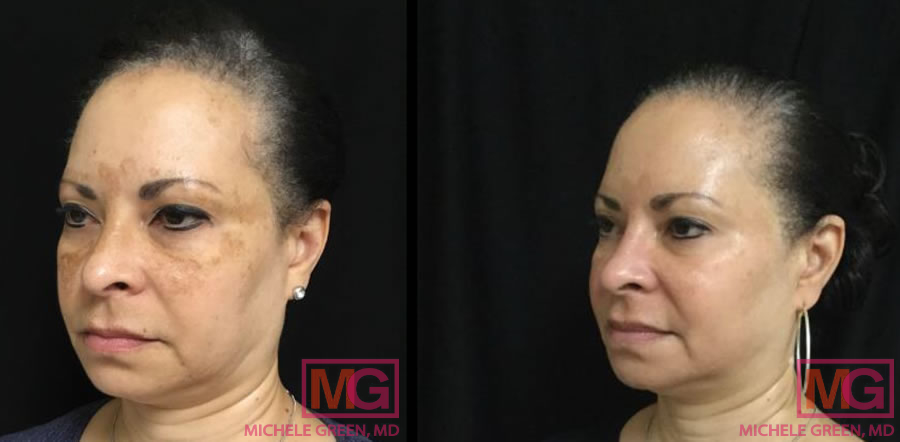
6 months after treatment with Cosmelan
Other Frequently Asked Questions
What do chemical peels do for your face?
A chemical peel exfoliates the surface layers of skin to slough away dead skin cells and stimulate new collagen production, resulting in smoother, brighter, healthier skin. Chemical peels can treat a variety of skin concerns, including sun damage, hyperpigmentation, acne scars, fine lines, and uneven texture or tone. Chemical peels also clear the pores and can be a beneficial treatment option for treating active acne. There are many different strengths and types of chemical peel, making it easy to customize to meet each patient’s individual needs. An experienced board-certified dermatologist, such as Dr. Green in NYC, can evaluate your skin condition and recommend the strength and type of chemical peel appropriate for your skin tone and type to achieve optimal results.
Are chemical peels worth it?
Yes! Chemical peels offer patients a non-invasive cosmetic treatment option for greatly improving the appearance of their complexion. They are one of the most versatile cosmetic procedures that can address various issues, from uneven skin tone to fine lines to dark spots to wrinkles, making a chemical peel treatment absolutely worth it! Additionally, they are often more inexpensive than many skin resurfacing laser treatments. Chemical peels can be a great treatment option for patients of any skin type and skin tone, even those of darker skin tones. They can often be used in conjunction with other cosmetic treatments for even better rejuvenation results. According to the most recent plastic surgery statistics report from the American Society of Plastic Surgeons, chemical peels remain among the top 5 most popular non-invasive cosmetic procedures in the United States- a true testament to their efficacy in treating a host of skin conditions!
What is the best chemical peel?
Actually, there is no “best” type of chemical peel. The best chemical peel for a patient must be determined during a consultation with an expert and based on your skin type, skin tone, the area of the body being treated, and the specific skin condition that needs to be improved. Generally speaking, fair-skinned patients can have stronger chemical peels than patients with darker skin tones. Patients with darker skin tones are more susceptible to developing hyperpigmentation as a side effect of chemical peel treatment. It is important to consult an expert in chemical peels, like Dr. Michele Green, who will understand which type of chemical peel will be best for your skin tone. Dr. Green treats individuals of all skin tones with chemical peels, including Asian, Hispanic, and African American patients.
Where can I get a chemical peel?
The best place to have your chemical peel is in the medical office of a board-certified healthcare professional, such as dermatologist Dr. Michele Green, in New York City. Although it may be more inexpensive to have a chemical peel in a spa or medical spa setting, improperly performed peels can result in dangerous and permanent side effects, such as scarring, hyperpigmentation, hypopigmentation, discoloration, or infection.
Can you do a chemical peel at home?
Mild chemical peels or exfoliating treatments can be done at home under the guidance of your dermatologist. These light peels can help with acne, sun damage, discoloration, and fine lines. Special care must not over-peel your skin and leave it irritated, discolored, or more uneven. There are many popular at-home products for chemical peels, such as MGSKINLAB’s Retexturizing pads, which contain salicylic acid and glycolic acid. Deeper chemical peels should never be performed at home. High percentages of TCA and phenol peels fall into this category since only board-certified dermatologists, like Dr. Green, are licensed to perform these types of deeper chemical peels. Attempting to perform a medium or deep chemical peel at home can result in dangerous and permanent side effects, including scarring and hyperpigmentation. Suppose you are interested in performing any chemical peel at home. In that case, it is essential to consult with a board-certified dermatologist like Dr. Green beforehand, as using a peel that is ill-suited for your specific skin type, tone, and concern can result in unwanted side effects.
How much is a chemical peel?
The cost for a chemical peel will vary depending on both the strength and type of chemical peel. Other factors that may influence the cost of a chemical peel include the expertise of your healthcare provider and the geographic location of the office in which you’re treated. The cost of a chemical peel can range from $700 to $2,500 and will typically be more costly if there is anesthesia or extensive preparation involved. A typical light chemical peel performed by a board-certified dermatologist generally is around 600 dollars per treatment. Spas, or clinics, with non-physician providers, offer chemical peel treatments that are cheaper and generally performed by technicians with less cosmetic experience treating patients with different skin colors and types of chemical peels. The risk of developing adverse side effects, including hyperpigmentation and scarring, increases when less experienced or uncertified practitioners perform chemical peels; therefore, it is important to seek treatment from a board-certified dermatologist, such as Dr. Green.
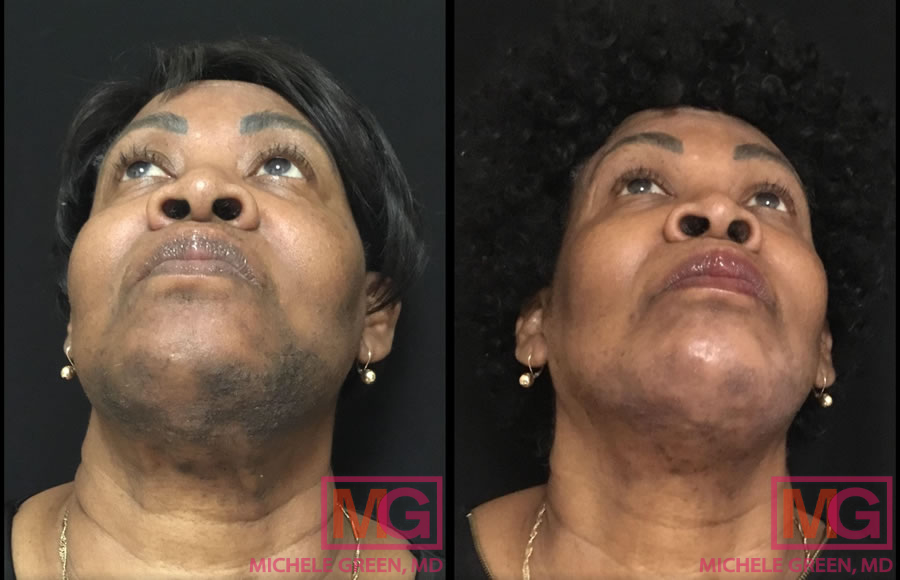
What does a chemical face peel do?
Chemical peels are an excellent treatment option for facial rejuvenation. Chemical peels damage the skin in a controlled manner, producing superficial wounds that stimulate the natural healing process. As your body works to repair the damage, there is collagen stimulation and increased skin cell turnover. Within a few days of peeling, a new skin layer will appear that is more even in tone and texture. Any areas where you may have had hyperpigmentation, age spots, sun spots, and discoloration should be faded and less visible. The result is a complexion that is healthier, clearer, brighter, and more youthful.
Do chemical peels help with acne?
Yes, chemical peels help with acne breakouts. Chemical peels can greatly reduce acne breakouts by using a chemical solution to exfoliate the skin, unclog the pores, eliminate acne-causing bacteria, and treat acne. Glycolic acid, salicylic acid, and light trichloroacetic acid peels are very effective chemical peel options for treating acne. It is best to have a series of these light peels to help exfoliate the skin and treat your acne breakouts.
An acne breakout after a chemical peel is normal and results from underlying bacteria coming to the surface. Large amounts of dead skin and inflammation resulting from the procedure can also contribute to mild breakouts as your skin tries to purge it. During this time, you can use a gentle cleanser twice a day. You can also apply a non-comedogenic moisturizer two to three times a day to ease any discomfort and soothe your skin. If you are going out in the sun, be sure to apply sunscreen. The best practice for treating post-peel breakouts is keeping your skin clean and hydrated, as it is more susceptible to bacteria and sun damage. After a few days or within the first few weeks, the breakouts should clear, and you should be left with healthy, beautiful skin.
Will chemical peels remove scars?
Chemical peels can be used to remove light scars that result from injury or acne. When applied to the scarred area, the chemical peel treatment exfoliates the epidermal layer of skin, which promotes the production of collagen. When the new skin cells replace the old tissue, the new skin is smoother in texture, reducing the appearance of scars. For atrophic or depressed acne scars, especially ice-pick scars, TCA Cross is a unique method of treating these scars with high concentrations of trichloroacetic acid. TCA Cross reduces enlarged pores and acne scars and promotes the production of new collagen and elastin. This new collagen production creates a more even complexion and improves the cosmetic appearance of your acne scars.
While many acne breakouts form atrophic scars, they can also result in uneven skin tone, hyperpigmentation, and dark marks. Chemical peels, combined with hydroquinones and retinoids, will smooth out your skin tone and leave it even and glowing. Chemical peels are best for light, superficial scars. For deeper scars, Dr. Green may recommend other cosmetic procedures, such as dermal fillers, Fraxel laser, or eMatrix laser.
Will a chemical peel help with wrinkles?
Chemical peels can help reduce the appearance of fine lines and wrinkles by using a chemical solution to remove the outer layers of damaged, old skin. The new skin that replaces it is usually smoother and less wrinkled. Additionally, chemical peels can stimulate collagen production, a protein essential for forming smoother skin. It is important to note that chemical peels alone may not give you your desired results and will not miraculously make your wrinkles disappear. Chemical peels are often paired with other cosmetic procedures like dermal fillers or Botox injections to improve the appearance of wrinkles.
Will chemical peels remove freckles?
Chemical peels can help reduce or remove hyperpigmentation, including freckles. However, freckles do tend to return following cosmetic treatment if sun exposure persists, as the skin cells that produce melanin are activated by sun exposure. For this reason, limiting sun exposure in the treatment area following a chemical peel is critical. Dr. Green advises wearing two layers of sunscreen, a chemical sunscreen first and then a physical sunscreen, for the best coverage. Sunscreens should be broad-spectrum, meaning they protect against UVA and UVB rays, and have a minimum SPF of 50. Wearing sun-protective clothing, including a wide-brimmed hat and sunglasses, can offer even greater protection. When you have your chemical peels with Dr. Green, she will provide you with a customized skincare protocol to adhere to that will help maintain the rejuvenation results of your treatments for long-lasting improvement.
Will a chemical peel remove dark spots?
Yes! Chemical peels are a great treatment option for reducing hyperpigmentation and dark spots. Several different types of chemical peels work well to treat dark spots, including a Mesopeel, Cosmelan peel, lactic acid peel, glycolic acid peel, TCA peel, and phenol peel. The type of chemical peel best suited to your skin condition depends on the severity of the discoloration and the patient’s skin tone. One of the best types of chemical peels for treating dark spots on the skin is the Cosmelan peel, which contains a proprietary combination of ingredients designed specifically to reduce discoloration on the skin, such as hyperpigmentation and melasma. The Cosmelan peel works on several levels to reduce discoloration on the skin by decreasing the production of the pigmentation melanin and inhibiting the movement of melanin from the melanocytes where the pigment is produced. As a result, the appearance of melasma or dark spots is reduced on the skin’s surface. The results can be maintained with various at-home skincare products that will be provided to you by Dr. Green on the day of your chemical peel.
How to treat hyperpigmentation after chemical peel
Hyperpigmentation can occur after a chemical peel for several reasons. First, hyperpigmentation can develop if there is sun exposure in the treatment area following a chemical peel. This can happen because a chemical peel increases the skin’s photosensitivity, making it more susceptible to UV damage. For this reason, it is critical to limit sun exposure in the treatment area following a chemical peel. Dr. Green recommends layering two broad-spectrum sunscreens with a minimum SPF of 50 for best protection. The first layer should be a chemical sunscreen, followed by a physical sunscreen. In addition, it is advised to wear sun-protective clothing, including a wide-brimmed hat and sunglasses.
Hyperpigmentation can also occur as a side effect if the strength or type of chemical peel is inappropriate for the patient’s skin type or tone. This is especially important for patients with darker skin tones, who can be more susceptible to discoloration and post-inflammatory hyperpigmentation following a chemical peel. This is why it is crucial that an experienced board-certified dermatologist, such as Dr. Michele Green, performs your chemical peel treatment. Dr. Green has over 25 years of experience providing non-invasive cosmetic procedures, including chemical peels. When you consult with Dr. Green, she will physically assess your skin condition, review your skin concerns and aesthetic goals, and work with you to develop a customized treatment plan that’s safe and effective for your skin type and tone and provides optimal results.
How do I get started with chemical peels today?
A chemical peel is an excellent non-invasive cosmetic procedure for addressing several skin conditions. A chemical peel uses a chemical solution to slough off dead skin cells and stimulate collagen production, revealing new, healthy, bright, smooth skin. A wide variety of skin concerns can be treated with a chemical peel, including sun spots, sun damage, acne scars, hyperpigmentation, melasma, dull skin, uneven texture, and fine lines. The side effects and downtime from a chemical peel depend on the type and strength of the chemical peel used. Chemical peels like the Mesopeel or Cosmelan peel are often the best treatment option for patients with darker skin, as they are safe and effective for all skin tones. At her private dermatology office in the Upper East Side neighborhood of Manhattan, Dr. Green performs many types of chemical peels, including Cosmelan, Mesopeels, TCA cross, and Dermamelan Intimate, to rejuvenate the appearance of the skin texture and skin tone for a brighter, clearer, smoother complexion that lasts. If you are ready to have a chemical peel to transform and rejuvenate your skin, Dr. Green is here to help.
Dr. Michele Green is an internationally renowned board-certified dermatologist with over two and a half decades of experience providing some of the world’s most discerning individuals with the best non-invasive cosmetic procedures, including chemical peels. She takes a holistic approach and embraces a less-is-more philosophy regarding facial rejuvenation, customizing each patient’s treatment plan to suit their particular concerns and aesthetic goals best. Dr. Green is consistently identified as one of New York’s best dermatologists by Super Doctors, Castle Connolly, New York Magazine, and The New York Times for her dedication to her patients and expertise. If you are looking for the best chemical peel treatment in New York, please call our office at 212-535-3088 or contact us online to develop your personalized treatment plan with Dr. Green today.
 212-535-3088
212-535-3088 